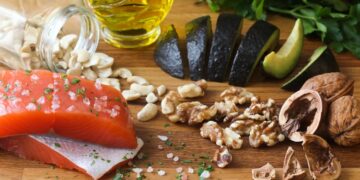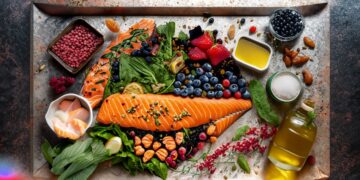To live healthfully, our internal system must be in balance, because when the body is balanced we can ensure we are running efficiently. Our diet plays a huge role in determining this, and it’s important that we pay close attention to how certain foods make us feel. There are many different diet modalities currently in circulation – vegan, Paleo, the Whole30, vegetarian, gluten-free – but they all have one common goal: to help us choose foods that will make us feel better so that we can ultimately reach our health goals. Regardless of the diet you follow, your number-one goal should always be to keep the body running smoothly so your internal health positively shifts as well. One way we can do this is by keeping our pH levels in balance by following a more alkaline-based diet.
Breaking it Down
You’ve likely heard the term “pH” before, but may not know where it falls into the nutritional spectrum. The pH, or potential of hydrogen, is a measure of how acidic or alkaline an item is. Our blood pH needs to maintain a slightly alkaline level to keep us healthy, and we can help our bodies to maintain this pH balance by eating more alkaline-forming foods and fewer acid-forming foods.
An alkaline diet helps balance the pH levels of the fluid in your body, including your blood and urine. These types of diets examine the minerals that the prescribed foods and meals contain, how they are absorbed by the body, and how those minerals affect your pH levels.
Understanding the Scale
Our pH is measured on a scale from zero to 14. The more acidic a food item is, the lower its pH, and the more alkaline it is, the higher that number. A pH of around seven is considered neutral, but since the optimal human body tends to be around 7.4, we consider the healthiest pH to be one that’s slightly alkaline. Our pH levels
will vary throughout the body, but not to worry – this is essential in order for it to function properly. For example, the stomach needs to be more acidic to aid digestion and allow your body to assimilate nutrients, while our skin only needs to be slightly acidic to prevent bacteria from being absorbed. There are many benefits to following a more alkaline diet and ensuring our body stays in a slightly alkaline state.
1. LOWERED CHRONIC PAIN AND INFLAMMATION
The ultimate goal of any healthy diet is to reduce chronic pain and inflammation. When it comes to an overly acidic diet, chronic acidosis (being in a state of high acidity) has been found to contribute to poor muscle recovery, inflammation, joint paint, chronic headaches or migraines, and elevated menstrual symptoms.
2. BETTER BONE DENSITY AND MUSCLE MASS
Keeping our minerals balanced and making sure we absorb the minerals we take in, such as calcium, helps prevent muscle wasting by enhancing the speed of our muscle recovery. Along with maintaining our muscle mass, many minerals are vital for proper bone density and bone structure, which is also a key factor in osteoporosis prevention.
3. IMPROVED IMMUNE FUNCTION
Along with vitamins, minerals play a huge role in the health of our immune system. Vitamin absorption is compromised by mineral loss, an outcome of a diet that is overly acidic, thus in turn weakening the immune system.
4. PREVENTS MAGNESIUM DEFICIENCY
Magnesium is required for the function of hundreds of enzyme systems and bodily processes. A lot of people deal with issues such as muscle cramping, muscle fatigue, migraines or general headaches, anxiety, difficulty staying asleep or falling asleep, restlessness, or heart palpitations. What many don’t know is that these are all signs of magnesium deficiency. Being a mineral, and one most people are deficient in, an overly acidic diet will usually pull magnesium out of the body and easily prevent absorption.
6. CAN HELP YOU MAINTAIN A HEALTHY WEIGHT
When it comes to maintaining a healthy weight or achieving a weight-loss goal, decreasing inflammation is crucial. By decreasing inflammation and leptin levels, you lower your hunger cues and enhance your fat-burning abilities. The most efficient way to manage this is through eating a more alkaline diet.

How to Combat Acidic Foods
Eating a 100 percent alkaline diet is not realistic because to stay balanced we need a little bit of both alkaline and acidic foods – we just shouldn’t swing too far in either direction. There are ways to manipulate your diet to reduce the impact of acidic food, including:
1 Increasing the amount of greens and other alkaline veggies during a meal.
For example, eat at least one large salad with one of your meals each day. Add things like sprouts, fresh herbs, bell peppers, and some dark leafy greens to reduce the acidic impact of the rest of your meal.
2 Squeeze lemon or lime juice into your water, on your fish, or use it in salad dressings.
3 Sprinkle or crack a little Himalayan sea salt onto your meals.
4 Snack on pumpkin seeds, almonds, or fresh fruits during the day.
5 Start using apple cider vinegar rather than balsamic vinegar. It contains much less sugar and could also be added to your water with a squeeze of lemon for the ultimate alkalinizing beverage.
6 Reduce your caffeine consumption by switching out one cup of coffee with a ginger or herbal tea.

STEPHANIE TUCCI, C.N.
is a culinary nutritionist and wellness chef with Nature’s Emporium. Read more at stephanietucci.com
Follow us on Facebook.
Follow us on Instagram.
Subscribe to our Youtube channel.















